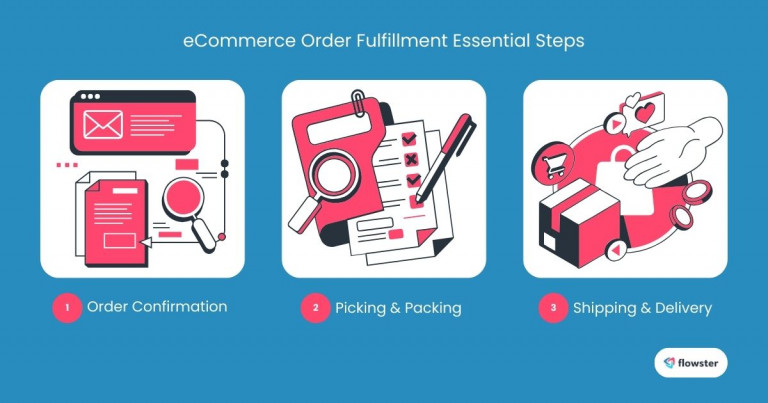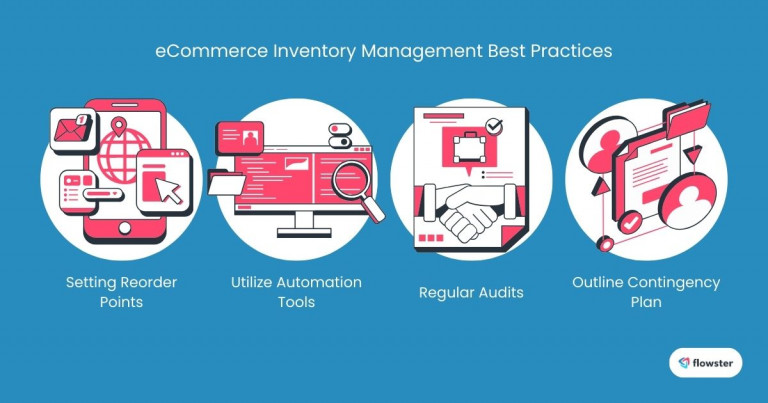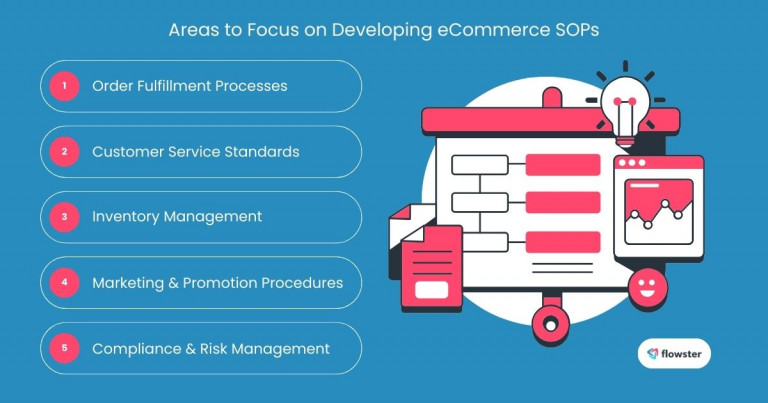Running an eCommerce business can be both exciting and overwhelming. Having clear procedures in place is essential for success due to the numerous moving parts involved. Standard Operating Procedures (SOPs) play a crucial role in streamlining operations and ensuring everyone is in agreement.
In this article, we’ll explore the top five areas to focus on when developing SOPs for eCommerce businesses. By honing in on these key aspects, you’ll not only enhance your efficiency but also improve customer satisfaction. So, let’s dive into the specific areas that will make your SOP development efforts truly impactful!
Article Outline
Order Fulfillment Processes: Streamlining Your Operations
Any eCommerce business relies heavily on order fulfillment. Order fulfillment plays a crucial role in converting an online order into a satisfied customer. When developing SOPs for eCommerce, focusing on order fulfillment processes is crucial. A well-defined process not only speeds up operations but also enhances the customer experience. Let’s break this down into two key components: creating a seamless order processing SOP and the importance of timely shipping and returns management.
Steps to Create a Seamless Order Processing SOP
Creating a smooth order processing SOP involves mapping out the entire journey from the moment an order is placed to when it’s delivered. Start by outlining essential steps such as order confirmation, picking, packing, shipping, and delivery. Each of these steps should have clear guidelines to ensure consistency.
For example, include instructions for verifying payments during order confirmation and best practices for packaging to avoid damage in transit. The clearer and more detailed your SOP, the easier it will be for your team to execute each task effectively.
Importance of Timely Shipping and Returns Management
Timeliness is everything in eCommerce. Customers expect quick shipping, and delays can lead to dissatisfaction and lost sales. A solid SOP for shipping should detail processing times, carrier options, and tracking procedures.
Additionally, don’t overlook returns management. An efficient return process can turn a frustrated customer into a loyal one. Outline the steps for handling returns, including how to communicate with customers and restocking procedures. By prioritizing these areas, you’ll create a more positive shopping experience and encourage repeat business.
For more insights on creating effective SOPs, check out this article: Creating Effective Standard Operating Procedures.

Customer Service Standards: Elevating the Customer Experience
Customer service is the face of your eCommerce business. Your reputation can be significantly impacted by how you manage inquiries and complaints. When developing SOPs for eCommerce, it’s essential to establish a consistent approach to customer service that will keep your customers coming back. Let’s dive into two critical aspects: establishing a consistent approach to inquiries and complaints and utilizing help desk software for efficiency.
Establishing a Consistent Approach to Customer Inquiries and Complaints
A unified approach to customer service is key to ensuring that every interaction reflects your brand. Start by creating templates and scripts for common inquiries. This not only helps your team respond quickly but also ensures that customers receive accurate information every time.
Consider providing guidelines on tone and language as well. Friendly and professional communication can go a long way in resolving issues. Training your staff regularly on these standards will help maintain quality, no matter who is handling customer interactions.
Utilizing Help Desk Software for Efficiency
In today’s fast-paced eCommerce landscape, relying on basic email or phone systems isn’t enough. Implementing help desk software can significantly improve your customer service efficiency. These tools allow you to track inquiries, manage tickets, and analyze response times, giving you valuable insights into your service performance.
Not only does help desk software streamline your operations, but it also enables your team to focus on providing high-quality support rather than getting bogged down by administrative tasks. This leads to quicker resolutions and happier customers.
For more strategies on improving your eCommerce operations, check out this article: How to Reduce Manual Errors in eCommerce.
Capture Your Processes in Minutes!
Inventory Management: Keeping Your Stock in Check
Effective inventory management is the backbone of a successful eCommerce business. It ensures that you have the right products available at the right time, preventing stockouts and overstocks. When developing SOPs for eCommerce, focusing on inventory management is essential to streamline processes and tackle common challenges. Let’s explore two key areas: best practices for stock control and replenishment SOPs and addressing challenges in supply chain disruption.
Best Practices for Stock Control and Replenishment SOPs
Having a solid inventory control system is crucial for maintaining optimal stock levels. Start by establishing clear protocols for tracking inventory. This includes setting reorder points that trigger restocking orders before you run out of popular items. You can also utilize inventory management software to automate this process, providing real-time insights into stock levels.
Additionally, consider regular audits and stock takes to ensure your inventory records are accurate. This helps identify discrepancies and allows you to make data-driven decisions. By implementing these practices, you’ll avoid the pitfalls of running low on stock or tying up cash in excess inventory.
Addressing Challenges in Supply Chain Disruption
Supply chain disruptions can significantly disrupt your inventory management plans. Whether it’s delays from suppliers or unexpected demand spikes, having a plan in place is vital. Create SOPs that outline contingency plans for various scenarios, such as alternative suppliers or emergency stock levels.
Diversifying your suppliers can also mitigate risks associated with supply chain disruptions. Ensure that your team is trained to adapt to changing circumstances and make quick decisions. By proactively addressing these challenges, you can maintain smoother operations even when unexpected issues arise.
For more insights on overcoming common eCommerce challenges, check out this article: Common Bottlenecks in eCommerce Workflows: How to Fix.

Marketing and Promotion Procedures: Boosting Your Brand Visibility
Marketing is crucial for driving traffic and sales to your eCommerce business. To effectively engage customers and maximize your promotional efforts, developing SOPs for eCommerce marketing and promotion procedures is essential. This section will look at creating SOPs for campaign management and social media engagement, as well as the importance of continuous optimization and A/B testing.
Creating SOPs for Campaign Management and Social Media Engagement
Having structured procedures for your marketing campaigns ensures that your messaging is consistent and aligned with your brand goals. Start by outlining a step-by-step process for planning and executing marketing campaigns. This includes defining objectives, choosing channels, and establishing timelines.
When it comes to social media engagement, create templates for common posts and responses. This helps maintain a cohesive voice across platforms and ensures that your team responds promptly to audience inquiries or comments. By specifying guidelines for engagement, you can foster a positive community around your brand.
Continuous Optimization and A/B Testing Processes
In marketing, what works today may not work tomorrow. That’s why continuous optimization is vital. Developing SOPs for A/B testing allows you to experiment with different headlines, images, or calls to action to see what resonates best with your audience.
Make sure to outline a clear process for creating, running, and analyzing A/B tests. This will enable your team to make data-driven decisions and refine your marketing strategies over time. By committing to a culture of testing and optimization, you’ll be better positioned to enhance your campaign performance and improve ROI.
For more tips on boosting your eCommerce strategy, check out this article: 5 Ways eCommerce Automation Can Boost Your Sales.
Flowster's AI-Driven Automation
Developing SOPs Around Legal Compliance and Data Protection
Compliance with laws and regulations is non-negotiable in eCommerce. Start by identifying the legal requirements that apply to your business, such as data protection regulations like GDPR or PCI compliance for payment processing. Documenting these requirements in your SOPs helps ensure your team understands their responsibilities.
Create checklists and processes for handling customer data securely, including how to obtain consent and manage personal information. Regular training sessions on compliance topics will keep your team informed and accountable, helping prevent costly legal issues down the line.
Crisis Management Protocols
Crisis situations can arise unexpectedly, and having a well-structured response strategy is crucial. Develop SOPs that outline steps to take in various crisis scenarios, such as data breaches, product recalls, or negative publicity.
Your SOPs should include communication plans for reaching out to affected parties and guidelines for internal coordination. Regularly reviewing and practicing these protocols can prepare your team to act swiftly and effectively in times of crisis, helping to minimize damage and maintain customer trust.
For more strategies on enhancing your eCommerce operations, check out this article: 7 Proven Strategies to Supercharge eCommerce Workflows.

Conclusion: Elevate Your eCommerce Operations with Effective SOPs
In the competitive world of eCommerce, developing SOPs is not just a good idea—it’s essential for maintaining efficiency and customer satisfaction. By focusing on key areas like order fulfillment processes, customer service standards, inventory management, and marketing procedures, and compliance, you can create a structured approach that empowers your team and enhances your operations.
With effective SOPs for eCommerce in place, your business can navigate challenges more smoothly and provide a consistent experience for your customers. Whether you’re a seasoned pro or just starting out, investing time in developing these procedures will pay off in the long run.
Ready to get started? You can access free templates to help you develop your own SOPs easily at Flowster Marketplace.




